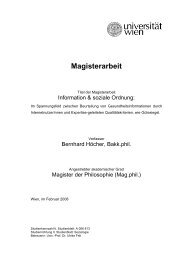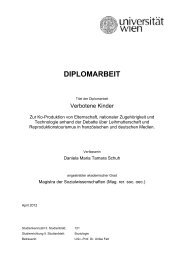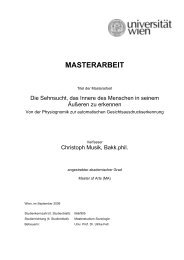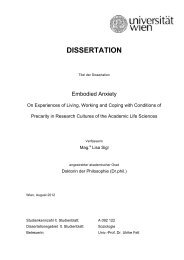MASTERARBEIT - Institut für Wissenschaftsforschung - Universität ...
MASTERARBEIT - Institut für Wissenschaftsforschung - Universität ...
MASTERARBEIT - Institut für Wissenschaftsforschung - Universität ...
You also want an ePaper? Increase the reach of your titles
YUMPU automatically turns print PDFs into web optimized ePapers that Google loves.
2.3 literature bodies about and around zeppelins 19<br />
both a chronological depiction of the technological development and<br />
the surrounding conditions. Yet he is more concerned about stating<br />
events than interpreting the environment of the airship to a greater<br />
extent. The history surrounding the technology and the biographical<br />
information serves more as a sort of frame for the technological narrative.<br />
After criticizing other redundant narratives, his original sources<br />
bring up some issues that are not mentioned by many other authors<br />
and thus provide some added material to the discourse. Two further<br />
publications by Knäusel are informative: »LZ1 - Der erste Zeppelin«<br />
[31] and »LZ1 - Die große Verheißung«[29]. Both books are identical in<br />
large parts. They provide a very nice account of the very beginnings<br />
of Zeppelin’s interest in airships and the efforts it took him to build<br />
his first prototype. Apart from the analysis Knäusel provides, the<br />
books offer a quite unique feature: Knäusel publishes reproductions<br />
of original documents from the time - speeches Zeppelin gave, letters<br />
to and from him and various other documents that offer first-hand<br />
insights into the difficult beginnings of Zeppelin’s airship venture.<br />
2.3.3 Studies of the Zeppelin from a Social Science Perspective<br />
While the former categories provide the frame of the entire story, for<br />
an STS research project the social science literature about and around<br />
count Zeppelin’s airship provides the most interesting pieces. Probably<br />
the most holistic approach comes from Guillaume de Syon [9].<br />
He gives a great overview – basically re-telling the entire history of<br />
Zeppelin airships from a fairly balanced perspective (not being German<br />
might be helpful at this point - if understanding the zeppelin<br />
as a technology with a national connotation, sharing the national<br />
cultural background in which it is remembered with such affection<br />
might prove to be a liability if one is not careful) and connecting the<br />
history of the technology with surrounding phenomena. He pays<br />
special attention to the relation of ’Germany’ to the technology – his<br />
book is subtitled »Germany and the Airship 1900-1939«. As his approach<br />
to cover the entire span of existence of the airship gives not too<br />
much room to the early developments, it still gives a very informative<br />
overview. In his book »Deutschland hebt ab«, Helmut Reinicke [42] lights<br />
the craze around the zeppelin airship from various perspectives. The<br />
perspectives he chooses cover various angles – focusing on different<br />
meanings the airship incorporated. Some important ones of those are<br />
the airship as an example for the general fascination for technology,<br />
the »national donation« (»Volksspende«) as a »cultic sacrifice« (original<br />
quote: »Opferfest des deutschen Volkes«, [42, 25]), the airship as<br />
symbol of upper class comforts in contrast to socialist tendencies and<br />
the airship as imagined supreme weapon. Giving a great amount of<br />
historic sources and material, a generally dramatic and elevated style<br />
of writing sometimes gives the impression of Reinicke himself being







